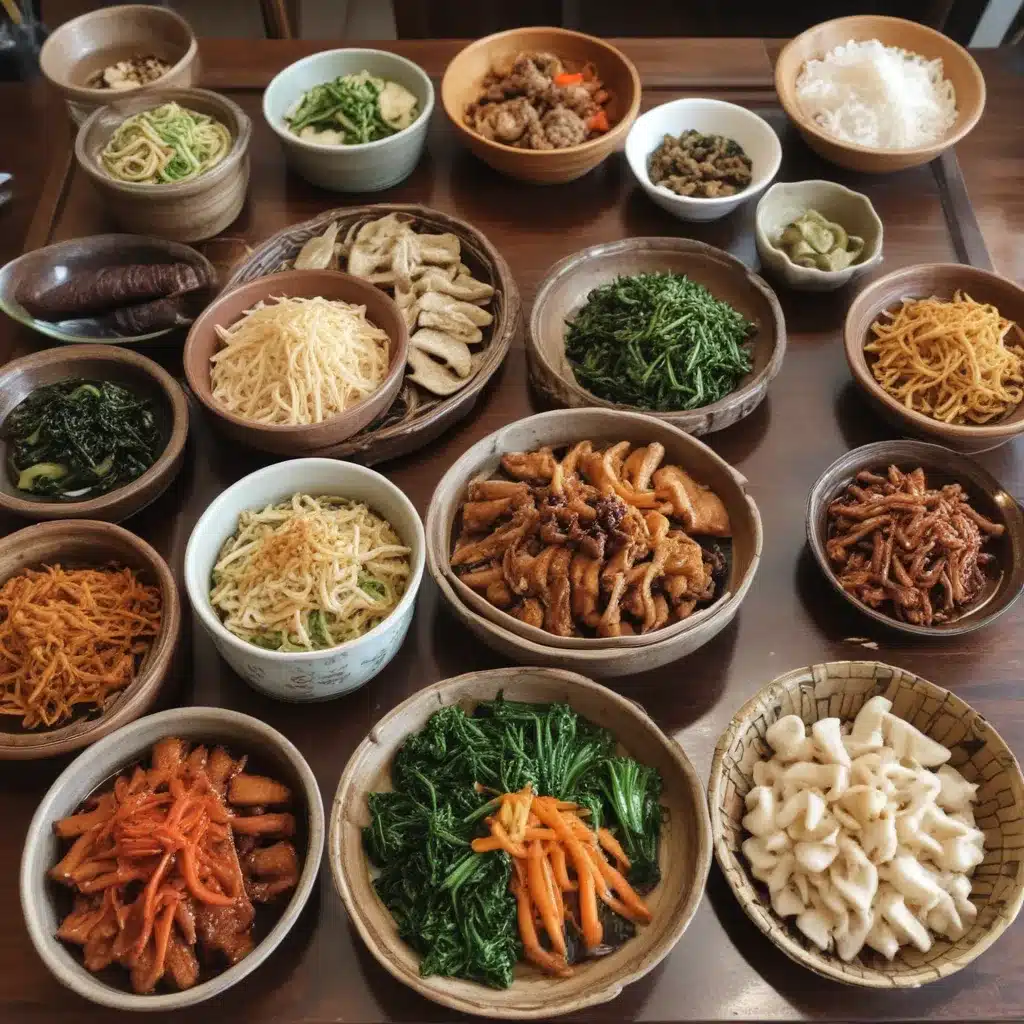
Discovering the Peaceful Flavors of Korea’s Monastic Culinary Tradition
As I stepped through the ornate gates of Gilsangsa Temple in Northern Seoul, the lush greenery and vibrant colors instantly enveloped me. Colorful lanterns hung from the trees, creating a serene, almost otherworldly ambiance. I had come to this sacred space to explore the fascinating world of Korean Buddhist temple cuisine – a 1,700-year-old culinary tradition that has captivated my senses and imagination.
My journey into this unique culinary realm began with a stroke of misfortune. I had read that Gilsangsa offered free vegan meals daily, and I couldn’t wait to indulge. Alas, the restaurant was closed due to the pandemic. Undeterred, I decided to explore the temple grounds, soaking in the tranquil atmosphere. As I wandered the lush pathways, I couldn’t help but notice the abundance of edible plants – from ginseng roots hiding in the soil to vibrant berries and delicate blossoms. It was clear this place was a treasure trove of natural ingredients, thoughtfully curated and respected by the resident Buddhist nuns.
As I learned from the esteemed nun WooKwan Sunim, the philosophy behind Korean temple cuisine is one of deep reverence for nature and the cyclical rhythm of the seasons. “Whenever I go to the mountain, I can see all the edibles out there,” she mused, her eyes twinkling with joy. “They are everywhere.” This profound connection to the land is at the very heart of this culinary tradition, which emphasizes the use of locally sourced, seasonal ingredients and a zero-waste approach to cooking.
The Essence of Temple Cuisine
As I continued my exploration, I discovered that Korean temple cuisine is much more than just a delicious vegetarian or vegan fare. It is a holistic practice rooted in the principles of Buddhism, where every step of the culinary process – from foraging to fermentation – is imbued with mindfulness and reverence for life.
One of the defining characteristics of temple cuisine is the avoidance of certain pungent ingredients, such as garlic, onions, and chives, which are believed to hinder a monk’s meditative practice. Instead, the chefs rely on an intricate interplay of flavors, textures, and seasonal variations to create dishes that are not only nourishing but also captivating to the senses.
As I sat down to sample the offerings at the renowned Balwoogongyang restaurant, I was struck by the sheer artistry and attention to detail in each course. From the delicate spring greens salad to the deeply savory fermented soybean stew, every element was meticulously prepared to showcase the natural flavors of the ingredients. Even the rice, with its vibrant yellow hue, was a revelation – the chef had used ground edible flowers to achieve this stunning color, a testament to their commitment to utilizing every part of the plant.
Mindful Eating and the Art of Restraint
But Korean temple cuisine is not just about the food itself. It is also a philosophy that encourages mindful eating and a profound appreciation for the resources that sustain us. As I learned, the practice of “eating meditation” is at the core of this culinary tradition, where one is encouraged to slow down, savor each bite, and contemplate the journey of the ingredients from field to table.
“Eating meditation tells us to stop and savor,” explained the writer and self-proclaimed carnivore-turned-occasional-vegetarian Zenkimchi. “It could be temple cuisine. It could be a fancy meal. It could be a hamburger. But don’t try it with a Big Mac unless chemicals sets make you hungry.”
This emphasis on restraint and mindfulness is not just about the individual diner’s experience, but also about the broader impact of our food choices. As WooKwan Sunim noted, “We only fill our bowl with what we need. We eat every last grain of rice.” This zero-waste approach, combined with the use of locally sourced, seasonal ingredients, demonstrates a deep respect for the environment and a commitment to sustainable living.
The Evolving Landscape of Temple Cuisine
While the core principles of Korean temple cuisine have remained unchanged for centuries, the modern-day challenges of urbanization and industrialization have posed some unique obstacles for those dedicated to preserving this culinary tradition. As WooKwan Sunim lamented, the encroachment of development projects on the forested lands surrounding Gameun Temple has made it increasingly difficult to forage for the wild ingredients that were once so readily available.
Yet, in the face of these challenges, a new generation of temple cuisine enthusiasts and practitioners are stepping up to carry the torch. Nuns like WooKwan are not only honing their craft but also sharing their knowledge with the wider world, as evidenced by her recent appearance on a Korean TV network to showcase temple-style zucchini dumplings. Additionally, restaurants like Balwoogongyang are bringing the essence of temple cuisine to the urban masses, earning a Michelin star for their efforts.
As I reflect on my experiences delving into the world of Korean temple cuisine, I am left with a profound sense of appreciation for this culinary tradition. It is not merely a set of recipes or a dietary restriction, but a way of life that embodies a deep reverence for nature, a commitment to sustainability, and a pursuit of mindfulness and balance. And while I may not be ready to entirely forgo the pleasures of garlic and onions, I have certainly gained a new-found respect for the creativity and wisdom that can blossom within the constraints of temple cuisine.
So, the next time you find yourself in Boston, I encourage you to visit Korean Garden and immerse yourself in the serene flavors of Korea’s monastic culinary tradition. Who knows, you may just discover a whole new world of gastronomic delight, where the simple becomes extraordinary, and the ordinary becomes transcendent.
